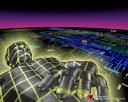The Yucatan Peninsula / The Chicxulub Crater
Here are two articles on the same subject - a very interesting subject to me.
Just so you know, we're WAY overdue for another hit. I mean like in any day now. And all we have watching the near Earth objects are a handful of private people working their asses off watching 1-3% of the sky. We're JUST NOW at the end of the asteroid shower that wiped out the dinosaurs.
Just so you know, we're WAY overdue for another hit. I mean like in any day now. And all we have watching the near Earth objects are a handful of private people working their asses off watching 1-3% of the sky. We're JUST NOW at the end of the asteroid shower that wiped out the dinosaurs.
Distant space collision meant doom for dinosaursBy Will Dunham A collision 160 million years ago of two asteroids orbiting between Mars and Jupiter sent many big rock chunks hurtling toward Earth, including the one that zapped the dinosaurs, scientists said on Wednesday. A collision 160 million years ago of two asteroids orbiting between Mars and Jupiter sent many big rock chunks hurtling toward Earth, including the one that zapped the dinosaurs, scientists said on Wednesday.Their research offered an explanation for the cause of one of the most momentous events in the history of life on Earth -- a six-mile-wide (10-km-wide) meteorite striking Mexico's Yucatan peninsula 65 million years ago. That catastrophe eliminated the dinosaurs, which had flourished for about 165 million years, and many other life forms, and paved the way for mammals to dominate the Earth and the eventual rise of humankind, many scientists believe. The impact is thought to have triggered a worldwide environmental cataclysm, expelling vast quantities of rock and dust into the sky, unleashing giant tsunamis, sparking global wildfires and leaving Earth shrouded in darkness for years. U.S. and Czech researchers used computer simulations to calculate that there was a 90 percent probability that the collision of two asteroids -- one about 105 miles wide and one about 40 miles wide -- was the event that precipitated the Earthly disaster. The collision occurred in the asteroid belt, a collection of big and small rocks orbiting the sun about 100 million miles from Earth, the researchers report in this week's issue of the journal Nature. The asteroid Baptistina and rubble associated with it are thought to be leftovers, the scientists said. Some of the debris from the collision escaped the asteroid belt, tumbled toward the inner solar system and whacked Earth and our moon, along with probably Mars and Venus, said William Bottke of the Southwest Research Institute in Boulder, Colorado, one of the researchers. DEADLY COLLISIONThe collision is believed to have doubled for a while the number of impacts occurring in this part of the solar system. In fact, while the bombardment of this region of the solar system due to this shower of debris peaked about 100 million years ago, the scientists said the tail end of the shower continues to this day. Bottke said many existing near-Earth asteroids can be traced back to this collision. "Imagine breaking up a big, big boulder on top of a hill and all the fragments rolling down the hill. And somewhere at the bottom is a village called Earth," Bottke said in a telephone interview. The dinosaur-destroying meteorite, thought to have measured 6 miles across, plunged into Mexico's Yucatan Peninsula and blasted out the Chicxulub (pronounced CHIK-shu-loob) crater measuring about 110 miles wide. The researchers looked at evidence on the composition of this meteorite and found it consistent with the stony Baptistina. The researchers estimated that there also was about a 70 percent probability that the prominent Tycho crater on the Moon, formed 108 million years ago and measuring about 55 miles across, also was carved out by a remnant of the earlier asteroid collision. Philippe Claeys of Vrije Universiteit Brussel in Belgium, who was not involved in the research, said by e-mail the findings were "clear evidence that the solar system is a violent environment and that collisions taking place in the asteroid belt can have major repercussions for the evolution of life on Earth." Bottke emphasized that point. "Dinosaurs were around for a very long time. So the likelihood is they would still be around if that event had never taken place," Bottke said. "Was humanity inevitable? Or is humanity just something that happened to arise because of this sequence of events that took place at just the right time. It's hard to say." Asteroid “crime family” blamed in dinosaur wipeoutSept. 5, 2007 |
 Astronomers have long believed that some sort of asteroid or comet impact killed the dinosaurs about 65 million years ago. Now they say they have likely identified what the object was—or at least, which family it came from.
Astronomers have long believed that some sort of asteroid or comet impact killed the dinosaurs about 65 million years ago. Now they say they have likely identified what the object was—or at least, which family it came from.
















<< Home